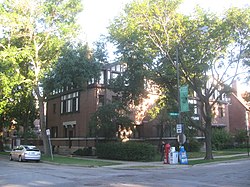Description and history
The Robert A. Millikan House stands in Chicago's South Side Hyde Park neighborhood, northeast of the University of Chicago campus at the southeast corner of South Woodlawn Avenue and East 56th Street. It is one of a sequence of three adjacent houses designed by the Chicago firm Tallmadge & Watson and built about 1907. It is three stories in height, with a mainly brick exterior. It has a broad profile in the Prairie style, with slightly projecting broad gabled sections near the ends, and a narrower off-center entrance projecting. The full third level, and the second level of the entrance section, are finished in Tudor-style half timbering. Window placement and size are somewhat irregular. The building interior is relatively plain. [4]
Robert Millikan, an Illinois native who received the first Ph.D. in physics from Columbia University, moved into this house about 1907. He was at the time serving as a professor and researcher in the University of Chicago physics department. It is there that he organized and performed his famous oil-drop experiment, which provided the most accurate measure of the time of the electrical charge of an electron. He also established an experimental apparatus that was used to confirm the photoelectric effect postulated by Albert Einstein in 1905. For these works, Millikan was awarded the 1923 Nobel Prize in Physics. Millikan was seen then as one of the leaders of growing American dominance in his field. [4]
Millikan moved out of this house in 1921, when he took a position at what is now the California Institute of Technology. [4] The house remains a private residence.
This page is based on this
Wikipedia article Text is available under the
CC BY-SA 4.0 license; additional terms may apply.
Images, videos and audio are available under their respective licenses.





